 Back to the Be Inspired Blog
Back to the Be Inspired Blog
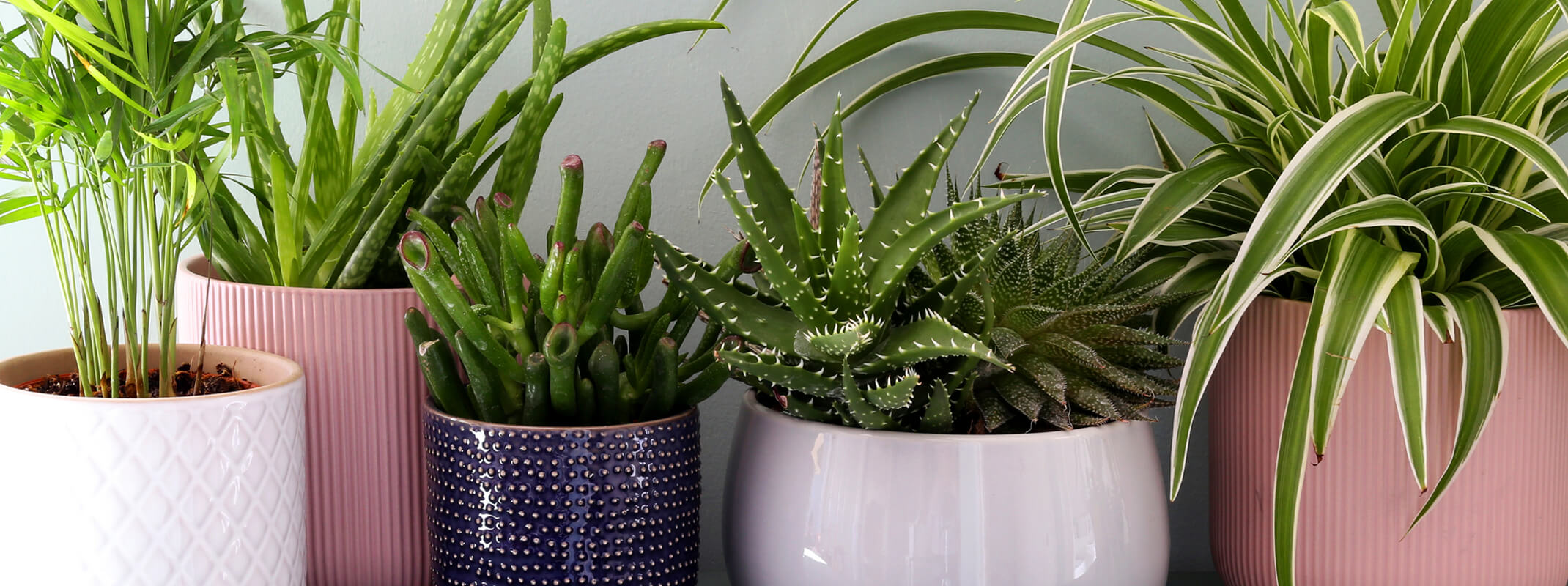
We've Selected The Best In Houseplants
We often think more about our houseplants during the cooler months when we’re hoping to add a little life indoors—and while many of our favorite outdoor plants lay dormant or are without blooms. However, summer is also an ideal time to be thinking about houseplants because the selection is so great!
Whether you have a space in your home or office that needs a little life or you have a college bound student who could use a little green in their new digs, houseplants are an excellent solution.
Houseplants not only provide texture, color and life, they also increase the humidity in the air—which decreases the occurrence of dry skin, colds, sore throats and dry coughs. Houseplants also improve your work environment, putting those nearby “under the influence of plants.” Plants improve concentration, memory and productivity. See... perfect for you and your college student!
We've identified "The Best" In Houseplants
1. The Best Houseplant Tree
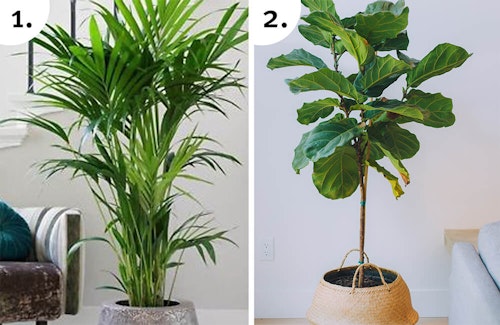
- 1. Kentia Palm - a more forgiving houseplant, will tolerate low-light conditions, as well as dust, heat and traffic. It does prefer indirect light but not necessarily bright. Kentias are tropical plants and do well in fast draining soil and water only when the top inch of the soil begins to dry out. Kentias are susceptible to root rot if watered too much or if the soil doesn’t drain fast enough. They are rarely affected by insects or disease but if mealybugs or mites do appear, we recommend Bonide Neem Oil. Excessive fertilizing of your Kentia Palm will appear through browning at the tips of the leaves. Your tree will also benefit by a nice misting once a week to provide some humidity.
- 2. Ficus Lyrata - prefers very bright but indirect light all day. Be careful not to choose a place for your tree that receives a great deal of traffic. Bumping and bending of leaves can cause them to bruise and turn brown, leading to an unattractive tree. Ficus Lyrata prefer moist soil but not wet because it can be susceptible to root rot. Great drainage and a wonderful potting soil is key. We recommend SummerWinds Potting Soil. Regular doses of a good fertilizer during the growing season (March-October) will only benefit your tree.
2. The Best Hanging Houseplants
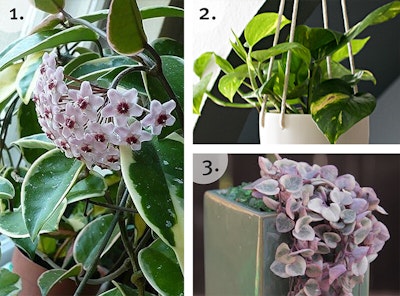
- 1. Hoya - This beautiful, classic vining creature, also known as a Wax plant is making a big return in popularity. It can grow to be enormous and offers fragrant star shaped flower clusters that almost look fake at first glance. Hoya's come in many varieties from dark green almond shaped leaves to a variegated round leaf. Most hoyas prefer bright but indirect light. Their large thick leaves hold a lot of water and are sensitive to over-watering.
- 2. Pothos are one of the most popular plant because they are so easy to grow and maintain. Chances are if you have one houseplant, it's a Pothos. If you find the right conditions, a Pothos will grow big and grow long. Correcting any problems that may occur with a Pothos is relatively easy. If it gets too leggy, simply cut it back. Place the cuttings in water and when it sprouts a root, place the root back in the dirt to create a lush pothos. Pothos thrive in bright but indirect sunlight but can tolerate low light. They really are a great starter houseplant for almost anyone. A popular variety right now is “Marble Queen.”
- 3. String of Hearts Ceropegia woodii - also known as Rosary Vine or Chain of Hearts is a lovely little trailing plant. It is compared to a succulent in the way it grows but actually belongs to the hoya family. It prefers bright light but no direct sun. And like succulents, let the soil dry out between waterings. Too much water is it's enemy. And if possible, water even less during the cooler months because that is when it becomes dormant. When transplanting, its best to do it in spring or summer and use a cactus and succulent mix.
3. The Best Houseplants For Low Light
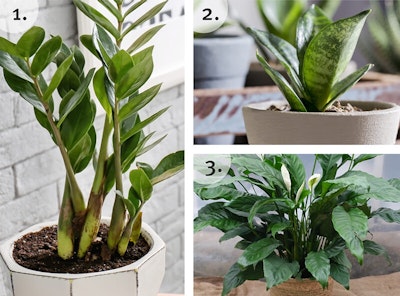
- 1. ZZ Plant Zamioculcas zamiifolia - Is the perfect plant for homeowners who want and love plants but suffer from "Brown Thumbitis." ZZ plants do best in bright/moderate but indirect light. It will also just fine in areas of low light. The best care for these houseplants is down right neglect. They prefer to be left alone and watered only when the soil has dried out. Yellow leaves on your ZZ plant either means too much light or too much water.
- 2. Snake Plant Sansevieria - also known as Mother-in-Law's Tongue, Snake Tongue, Mothers Plant and Viper's Bowstring-hemp. All very unattractive names for an attractive houseplant. It does well in both bright and low-light areas. Snake Plants prefer well draining soil and although this houseplant will stand more neglect than almost any other plant, overwatering is harmful. These plants look amazing on their own or with other like-minded houseplants.
- 3. Peace Lily Spathiphyllum - are available in solid to variegated varieties. Variegated Peace Lilies are very popular right now. The soil for the Spathiphyllum 'Peace Lily' Variegated should be kept moist but not soggy. Let the soil dry between waterings, but do not allow to wilt; this causes the leaves to yellow. These plants do well in lower light situations, but prefer bright/filtered but indirect light. The plant requires a large pot and should be kept somewhat potbound. If you do need to repot, do so in spring.
4. The Best Flowering Housplants
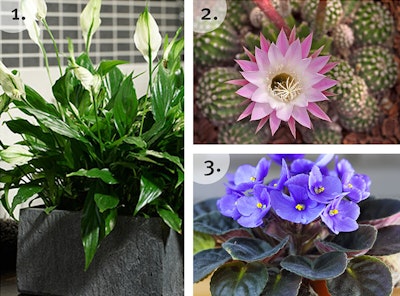
- 1. Peace Lily - (mentioned above)
- 2. Easter Lily Cactus Echinopsis oxygona - Deep pink buds on tall stems burst open to large eye-catching blooms with striking pink petals that fade to white towards the flower centers. The showy blooms rise from the white spine-jeweled ribs of this clump-forming, cylinder-shaped green cactus in spring. Thrives in average loams to lean, sandy soils with excellent drainage.
- 3. African Violets Saintpaulia - are those classic beauties you may remember seeing in your Grandmother's home. Their soft fuzzy leaves and clusters of dainty purple, pink or white flowers make this houseplant a must have. African Violets prefer moderate to bright, indirect light. They don't like wet leaves so be sure to water from the bottom up with room temperature water. They prefer moist but not soggy soil and when their blooms are spent, pinch them off to encourage new growth. For best results, use violet plant food as directed.
5. The Best Houseplants For Easy Maintenance
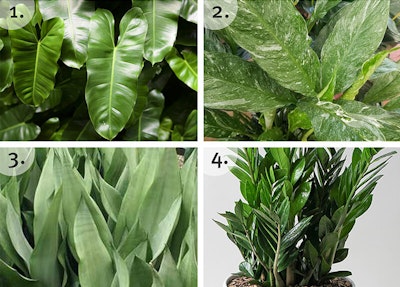
- 1. Philodendron - are available in the climbing and non-climbing types. Philodendrons prefer dappled, bright light and moist soil at all times. Because they are native to tropical regions, they benefit by frequent misting during the growing season. Philodendrons like rich, loose potting soil.
- 2. Peace Lily - (mentioned above)
- 3. Snake Plant - (mentioned above)
- 4. ZZ Plant - (mentioned above)
6. The Best Houseplants For Bedroom and Bath
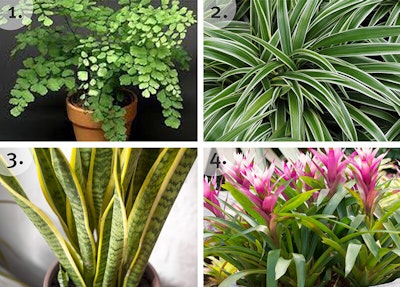
- 1. Maidenhair Fern Adiantum spp. – prefers small containers and dislikes repotting. A low maintenance houseplant that has some simple basic needs. They enjoy bright but indirect light. They like a little humidity so either mist daily or place the plant in a water-filled pebble tray. Maidenhair Ferns like moist but not soggy soil. Be careful not over water or dry out the plant. However, if you do let it get a bit dry, don’t give up on it right away. Give it a good soaking and it will eventually produce new leaves.
- 2. Spider Plant Chlorophytum comosum - This plant is another easy to grow houseplants. It has few challenges other than brown tips. The spider plant is so named because of its spider-like plants, or spiderettes, which dangle down from the mother plant like spiders on a web. Provide them with well-drained soil and bright, indirect light and they will thrive. Spider Plants like moist but not soggy soil and prefer to dry out between waterings
- 3. Snake Plant - (mentioned above)
- 4. Bromeliad - houseplants need medium to bright light as indoor specimens. This plant doesn’t need deep pots and prefer a low soil medium such as orchid mix, a blend of bark, sphagnum moss and other organic amendments. Bromeliads come with their own measuring cups for watering. Simply fill the cup formed at the base by the leaves. Any water that filters down to the pot should be emptied regularly to eliminate the lure of insects. A saucer with pebbles and water can be placed under the pot to encourage humidity.
7. The Best Trending Houseplants

- 1. String of Hearts - (mentioned above)
- 2. Ficus Lyrata - (mentioned above)
- 3. Begonia maculata - make an attention grabbing houseplant on it’s own or when accompanying other like-growing plants. Care is easy as the Begonia maculata requires very little attention. It prefers moist, well-drained soil.
- 4. Hoya - (mentioned above)
8. The Best Houseplants For Dorm Rooms
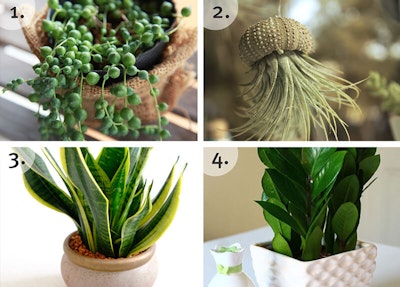
- 1. String of Pearls - (mentioned above)
- 2. Air Plants tillandsia - In order to thrive, air plants need bright, indirect light. Careful not to place too close to the window or you will fry your air plant. The higher the humidity in your space, the more light is tolerated by the air plant. If you’re putting your air plant where it will receive loads of light, you should plan to mist it more often - twice a week or even daily. A sunny bathroom makes a happy home for an air plant, because the humidity from your shower will take care of most plant misting for you. Every 3 weeks soak your air plant in room temp water for about 7 minutes, take out and place upside down to dry. Otherwise, once a week, mist your plant thoroughly, so that the entire surface of the plant is moistened (but not so much that there is water dripping down into the plant).
- 3. Snake Plant - (mentioned above)
- 4. ZZ Plant - (mentioned above)
9. The Best Succulent Houseplants
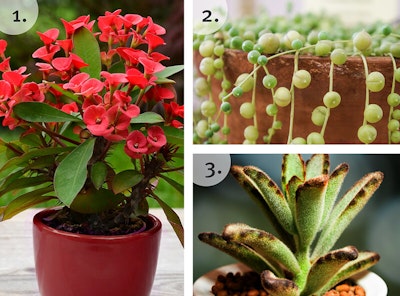
- 1. Crown of Thorns Euphorbia milii - is a special succulent because it is not only beautiful, it adapts well to normal room temperatures and in dry indoor environments. To be successful with the Crown of Thorns houseplant, it starts with placing it in the best possible location. It prefers to be in a window with 3 to 4 hours of direct sunlight every day.
Spring through late fall, water the crown of thorns plant when the soil is dry at a depth of about an inch. Flood the pot with water and once the excess has drained through, empty the saucer to eliminate potential root rot. In winter, allow the soil to dry to a depth of 2 or 3 inches before watering. Feed the plant with a liquid houseplant fertilizer. Water the plant with the fertilizer every two weeks in spring, summer and fall. In winter, dilute the fertilizer to half strength and use it monthly. Crown of Thorns is poisonous to pets, so please find a spot out of their reach. - 2. String of Pearls - If you’re looking for an easy succulent to grow indoors, string of pearls is your plant. It prefers bright light and a well-draining sandy soil. Display or plant so it can hang or trail to show off its true potential. This succulent plant is drought tolerant, surviving long periods without water. Allow the soil to dry out at least half an inch or so between waterings. In winter, cut back watering to about once monthly. Trim off any dead stems and pearls, as well as any stems that have lost a lot of their ‘beads.’ Pruning back will help promote fuller, more compact plants.
- 3. Panda Plant Kalanchoe Tomentosa - The indoor panda plant is a hardy succulent that makes an interesting addition to the houseplants you grow indoors. Place in medium to bright light. Allow the soil to dry between waterings.
10. The Best (Our Favorites) By SummerWinds Locations

We asked each of our SummerWinds for their favorite houseplant and why...
- 1. Peace Lily - Was chosen by our Campbell location because it blooms anywhere and can be placed everywhere.(details about the plant - mentioned above)
- 2. Ficus Lyrata - Both our Palo Alto and Cupertino chose the Ficas Lyrata simply put, they are desired by many(details about the plant - mentioned above)
Additional houseplant information
Please note that not all varieties of houseplants listed above are available at all locations at all times of the year

